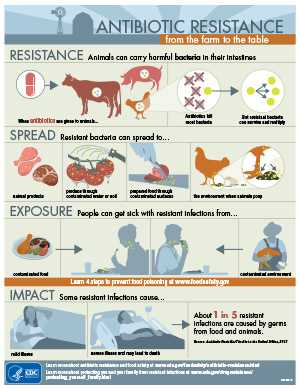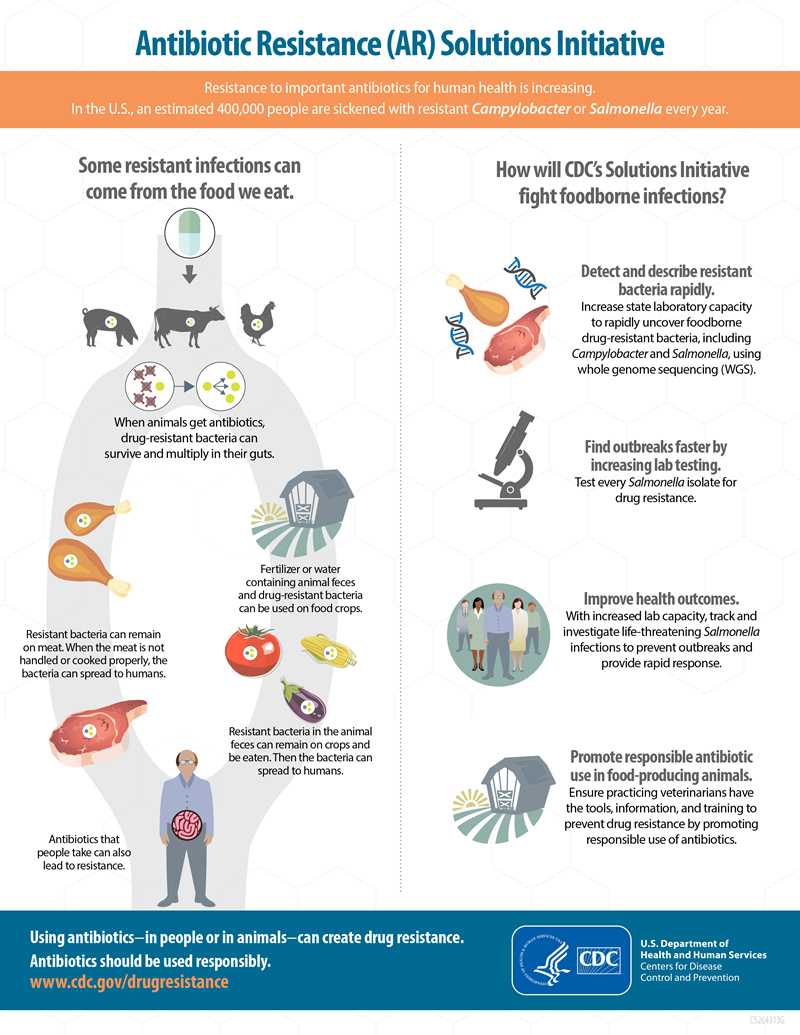Antibiotic Resistance
NARMS – Combating Antibiotic Resistance with Surveillance
Antibiotic resistance is one of the world’s most pressing public health problems. Illnesses that were once easily treatable with antibiotics* are becoming more difficult to cure and more expensive to treat. Infections from common antibiotic-resistant foodborne bacteria, such as Salmonella, can cause more severe health outcomes than infections with bacteria that are not resistant to antibiotics.
Through NARMS, experts track and study changes in antibiotic resistance among several bacteria transmitted commonly through food.
Studies using NARMS data increase our understanding of resistance trends, new or emerging combinations of resistance, which resistant bacteria are making people sick, and which groups are at risk and why.
NARMS data help guide efforts to protect people from resistant infections. Organizations and groups using NARMS data include federal regulatory agencies, policymakers, consumer advocacy groups, health departments, industry, and the public.
*This site uses the term “antibiotics” to refer to antimicrobial agents used to treat bacterial infections in both people and animals.
Frequently Asked Questions
What is antibiotic resistance?
Antibiotic resistance is the ability of bacteria to resist the effects of an antibiotic—that is, the bacteria are not killed, and their growth is not stopped.
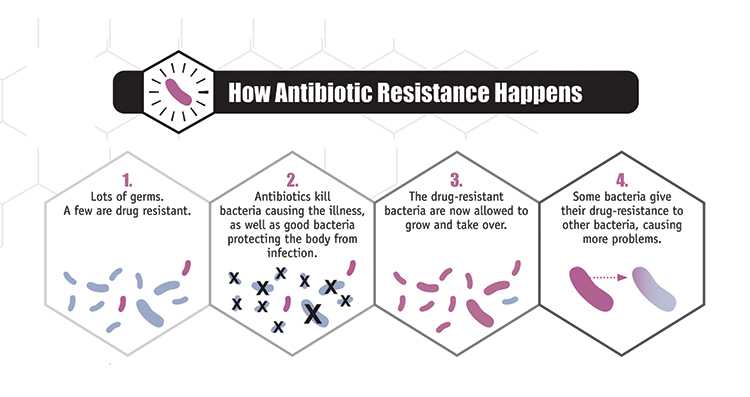
Learn more at https://www.cdc.gov/drugresistance/about.html
How does antibiotic use in food animals affect people?
All animals carry bacteria in their intestines. Giving antibiotics to animals will kill many bacteria, but resistant bacteria can survive and multiply.
- When food animals are slaughtered and processed, these bacteria can contaminate the meat or other animal products.
- These bacteria can also get into the environment through animal stool and may spread to produce that is irrigated with contaminated water.
Food can get contaminated whether the bacteria are resistant to antibiotics or not.
How do people get infections with resistant bacteria from animals?
Here are ways that people can be exposed to resistant bacteria from animals:
- From handling or eating raw or undercooked food from animals or produce contaminated with resistant bacteria
- From contact with animal stool (either directly or when it gets into water for drinking, swimming or growing plants)
- From touching or caring for animals
What effects do resistant infections have on people?
Some resistant infections cause severe illness. People with these infections:
Antibiotic Use and Healthcare
Did you know nearly half of antibiotic use in hospitals is unnecessary or inappropriate?
Visit CDC’s Get Smart for Healthcare website to learn how improving antibiotic use in hospitals can reduce rates of infection and antibiotic resistance, improve patient outcomes, and save hundreds of thousands of dollars.
- May be more likely to be hospitalized and have higher medical expenses;
- May take longer to get well again; or
- May die from the infection.
How do we know that antibiotic use in food animals is linked to resistant infections in humans?
Scientists around the world have provided strong evidence that antibiotic use in food animals can lead to resistant infections in humans. Studies have shown that:
- Antibiotic use in food animals allows antibiotic-resistant bacteria to grow and crowd out the bacteria that do respond to antibiotics;
- Resistant bacteria can contaminate food from the animals; and
- Resistant bacteria in food can cause infections in humans
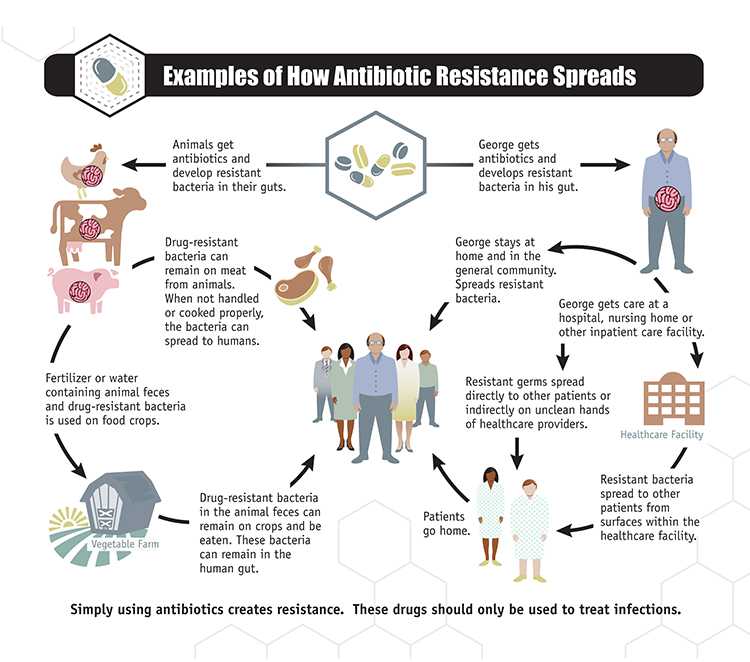
Why is it important to use antibiotics responsibly in food animals?
Visit FDA’s Strategy on Antimicrobial Resistance to learn more about their guidance on judicious use of antibiotics in agriculture
Antibiotics must be used responsibly in both humans and animals because both uses help bring about the development, persistence, and spread of resistant bacteria. Antibiotics are valuable tools for reducing animal disease and suffering from bacterial infections, but decisions about which antibiotics to use in food animals and how to use them must be made with consideration of their potential impact on human health.
Any use of antibiotics can lead to resistance. However, when animals are given antibiotics for growth promotion or increased feed efficiency, bacteria are exposed to low doses of these drugs over a long period of time. This type of exposure to antibiotics may lead to the survival and growth of resistant bacteria. This is inappropriate antibiotic use.
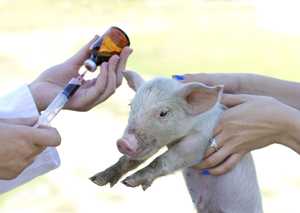
Visit FDA’s Strategy on Antimicrobial Resistance to learn more about its guidance on using antibiotics responsibly in food animals.
What uses are antibiotics approved for in food animals?
FDA has approved antibiotics for these uses in food animals:
- Disease treatment for animals that are sick;
- Disease control for a group of animals when some of the animals are sick;
- Disease prevention for animals that are at risk of becoming sick.
What is CDC doing to prevent foodborne infections caused by antibiotic resistant bacteria?
Preventing foodborne and other intestinal infections reduces both infections that can be treated effectively with an antibiotic and antibiotic-resistant infections. CDC activities that help prevent these infections include:
Tracking Resistance
- Tracking resistance in infections
- Estimating how many antibiotic-resistant infections occur
- Collaborating with domestic and international partners to monitor resistance and improve detection capacities
- Studying how resistance emerges and spreads
Identifying Sources of Infection
- Determining the sources of antibiotic-resistant infections that are commonly spread through food
- Investigating antibiotic-resistant infections to solve and stop outbreaks and improve prevention
- Developing better tools to rapidly and accurately find sources of food contamination
Improving Food Safety
- Strengthening the ability of state and local health departments to detect, respond to, and report antibiotic-resistant infections
- Educating consumers and food workers about safe food handling and proper handwashing
- Identifying groups with a greater chance of infection and educating them about how to reduce the likelihood of illness
- Promoting the responsible use of antibiotics in animals as well as humans.
What can I do to reduce the chance of infection with resistant bacteria from foods?
You can reduce the chance of getting a resistant bacterial infection by following some easy recommendations for safe food handling and preparation.
- Follow FoodSafety.gov’s Clean, Separate, Cook, and Chill guidelines.
- Cook meat, poultry, and eggs to a safe minimum internal temperature.
- Prevent animal products from contaminating other foods by washing your hands, utensils, and kitchen surfaces during meal preparation.
- Don’t drink raw milk.
- Wash your hands after contact with stool, animals, or animal environments.
- Review CDC’s Traveler’s Health recommendations when preparing to travel to a foreign country.
Learn more about Antibiotic Resistance and Food Safety.
- Page last reviewed: October 26, 2016
- Page last updated: December 16, 2016
- Content source:



 ShareCompartir
ShareCompartir
